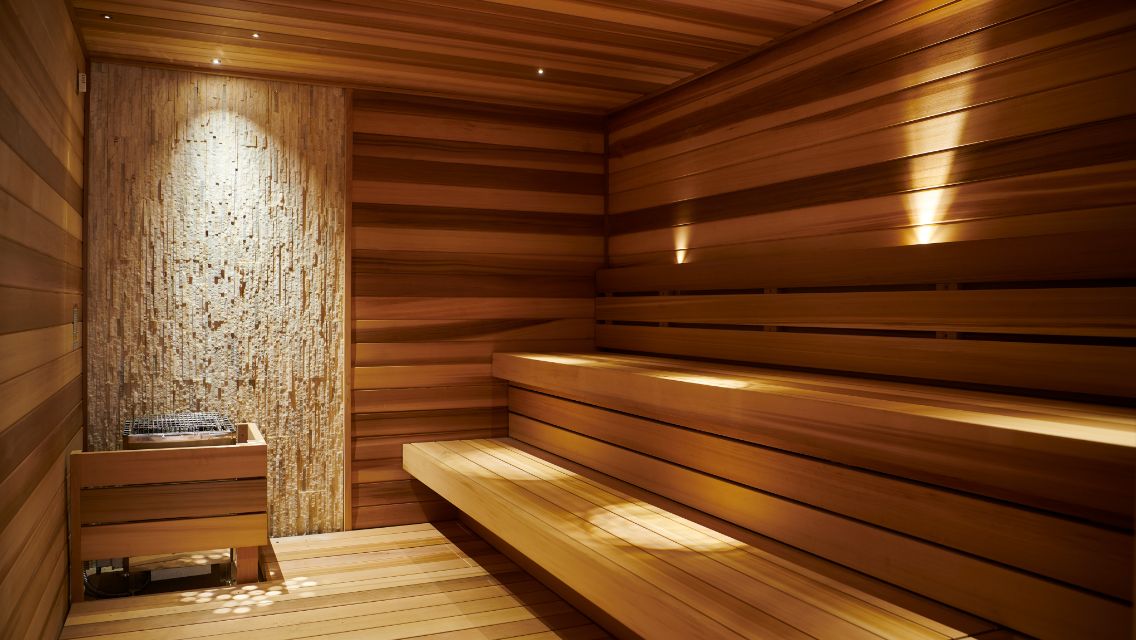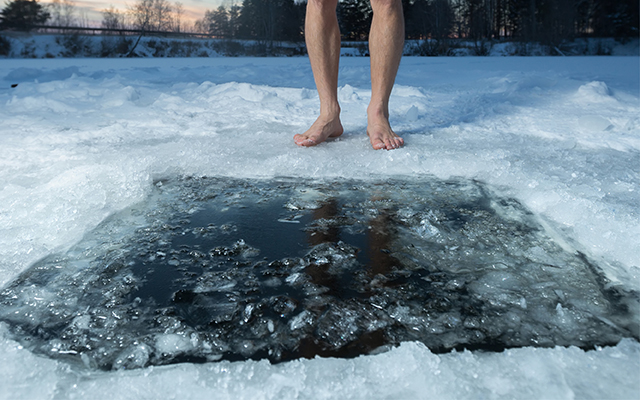There’s no way to truly prepare myself. I know it’s going to be cold — really cold. I tense my muscles, perhaps in the vain hope of retaining body heat. But when I hit that icy water, it’s colder than I could ever have imagined.
That’s when it sinks in that a midwinter swim is named after polar bears for good reason.
The scene is a January eve on the Kawishiwi River in the Boundary Waters Canoe Area Wilderness near Ely in far northern Minnesota. This is the land where wolves still howl at the moon and the aurora borealis shines bright. Snow blankets the hibernating earth and the night air hovers at 10 degrees F: This means that the water in the hole chopped through the ice is quickly covered by a glaze.
In the interest of full disclosure, my compatriots and I are not doing much actual swimming. And we’ve just emerged from a sauna’s fiery glow; so, while our bodies hold that wood-fired warmth, it also makes the frosty river seem even frostier by comparison. We make the leap, descend deep down into the dark chill — and then shoot out again like Fourth of July fireworks.
Back in the sauna’s embrace, I surprise myself by yearning to do it all over again.
Just as “cold” cannot begin to describe the water, “invigorated” fails to explain how alive I feel afterward.
Why Do a Polar Bear Plunge?
A cold plunge is a wintertime dip in a river, lake, fjord, sea, ocean — or even glacial waters. Such ice bathing dates back centuries in Russia, Finland, Norway, and Sweden.
In 1903, the Coney Island Polar Bear Club founded the first U.S. winter-bathing club. Today, polar plunging is a hot trend in cold spots around the globe. New Year’s Day has been christened the official Polar Bear Plunge Day, on which folks are ready to charge the freezing water for fundraisers or simply for “fun.”
But the real question is, Why?
It’s a bragworthy challenge, certainly. But extreme cold-water bathing also boasts some surprising health benefits and healing powers.
“The immediate impact of cold water on our bodies can be uncomfortable, if not downright painful. It is therefore understandable why some might be reluctant to willingly submit to that discomfort,” writes “the Iceman,” Wim Hof, who has set some two dozen Guinness World Records, including several for braving the coldest of cold.
As part of his prescription for living fully, which he outlines in The Wim Hof Method: Activate Your Full Human Potential, Hof recommends daily deep-breathing exercises and icy showers. To paraphrase the old saw, he preaches that cold water every day keeps the doctor away.
Cold-water exposure prompts vasoconstriction — a shrinking of the blood vessels — especially in the peripheral parts of the body, such as the arms, hands, feet, and ears. Your body counters with vasodilation, enlarging those arteries, veins, and capillaries to flood them with fresh blood. This supercharges your cardiovascular system, spurs metabolism, and helps restore cells after secondary injury.
Some adherents also report that taking the plunge lowers their resting heart rate and consistently elevates their heart rate variability. (For more on cold conditioning, see “3 Hot and Cold Therapies for Postworkout Recovery.”)
Cold-water exposure also helps restore your body by quelling inflammation and reducing swelling. This can ease aches and pains and boost both exercise and injury recovery. (For more on the benefits of cold for recovery, listen to Life Time master trainer Danny King on the Life Time Talks podcast at “Why Cold for Recovery?“)
Still, perhaps the most astonishing aspect of cold-water exposure is how it effects your brain and your mind.
How Cold Water Immersion Improves Mental Health
In her book Wintering, Katherine May describes feeling frozen in life. She — very reluctantly — goes for a winter swim with another woman and finds comfort in the cold: Plunging into the North Sea brings a “high” and produces an antidepressive effect.
“Encountering the extremes of cold drew us both into that most clichéd space, the Moment, forcibly pulling our minds away from ruminating on the past or future, or tilling over an endless to-do list,” May writes.
“Regular cold-water swimming creates the same chemical mix in your bloodstream that ecstasy does. You feel incredibly euphoric but also blissful and peaceful. It’s a really lovely feeling. You get a massive dopamine hit; you get loads of serotonin flowing through your bloodstream.”
Cold water jolts the body into releasing a rush of hormones, including mood-boosting norepinephrine neurotransmitters and pain-relieving endorphins that can reduce stress, improve sleep, and boost overall mood. One study found that cold-water immersion raises levels of the brain’s feel-good chemical dopamine by a whopping 250 percent.
“Regular cold-water swimming creates the same chemical mix in your bloodstream that ecstasy does,” May explains in the online journal Maple. “You feel incredibly euphoric but also blissful and peaceful. It’s a really lovely feeling. You get a massive dopamine hit; you get loads of serotonin flowing through your bloodstream.
“It’s very hard to pinpoint, but it happens as soon as you get in the water. There’s this kind of shedding of stress. . . . There’s good evidence that it alleviates depression and anxiety. Specifically, putting your head under the water helps to sort of soothe the vagus nerve that runs from your brain right down into your lower body.”
Taking the Plunge
Once winter arrives, Barbara Powell goes ice swimming most weeks in Minneapolis’s Cedar Lake. “I adore the entire chilly, uncomfortable experience!” she says.
Wearing naught but a bathing suit, mittens, hat, and slip-on shoes, Powell joins a group of like-minded friends for a five- to 10-minute soak. “We treat the plunge as a place of community, just like you would a weekly coffee get-together or church service.”
Powell, MA, NBC-HWC, is a Life Time Mind coach, and beyond the physical sensations of the plunge, it’s the heady effects that she appreciates most.
“Getting in — I just have to do it. No thoughts. Just feet first, hop down,” she explains. “The first 30 to 60 seconds are the worst. It’s a shock; the body and mind do not like it. It’s important for me to calm my mind through nose breathing.
“I am typically flushed with a euphoria immediately after that lasts about an hour or so. My world looks brighter, I feel quite alive, and I really enjoy the thrill of my body reacclimating to ‘regular’ temperature air.”
More Ways to Chill Out
You don’t have to make like a polar bear to expose yourself to intense therapeutic cold. Try these other ways to get chilly.
- Take a dip in a cold-plunge tub or schedule a cryotherapy session at your local health club or spa. (For more on cryotherapy, visit “The Health Benefits of Cold Conditioning.”)
- Draw your own ice bath at home any time of the year or take cold showers.
- Go for a swim in the ocean, one of the Great Lakes, or a mountain stream — it can get your system racing, even in the summertime.





This Post Has 0 Comments